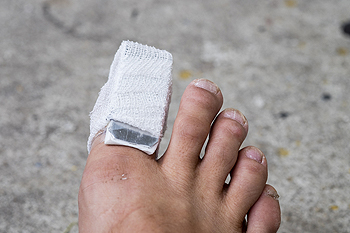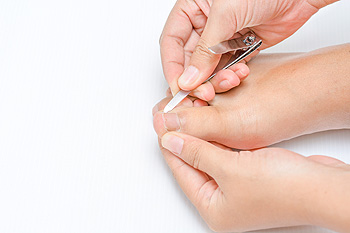March 2019
Types of Arthritis That May Affect the Feet
 Common symptoms that are associated with arthritis in the feet may include swollen joints, pain, or stiffness. Rheumatoid arthritis is a painful condition that is triggered by the body’s immune system. The small joints in the feet are often affected and this may lead to the development of additional foot conditions. Many patients have a form of arthritis that is known as gout, and this is typically caused by having elevated uric acid levels in the bloodstream. The side of the big toe is generally affected, and preventive measures can be implemented which may include healthy dietary changes. There may be medical conditions that can precede the development of arthritis. These may include psoriasis, osteoporosis, and scleroderma. If you would like information about how these forms of arthritis affect the feet, it is suggested to speak to a podiatrist.
Common symptoms that are associated with arthritis in the feet may include swollen joints, pain, or stiffness. Rheumatoid arthritis is a painful condition that is triggered by the body’s immune system. The small joints in the feet are often affected and this may lead to the development of additional foot conditions. Many patients have a form of arthritis that is known as gout, and this is typically caused by having elevated uric acid levels in the bloodstream. The side of the big toe is generally affected, and preventive measures can be implemented which may include healthy dietary changes. There may be medical conditions that can precede the development of arthritis. These may include psoriasis, osteoporosis, and scleroderma. If you would like information about how these forms of arthritis affect the feet, it is suggested to speak to a podiatrist.
Arthritis can be a difficult condition to live with. If you are seeking treatment, contact Dr. Lee R. Stein from Lake Shore Foot & Ankle, PC. Our doctor can provide the care you need to keep you pain-free and on your feet.
Arthritic Foot Care
Arthritis is a joint disorder that involves the inflammation of different joints in your body, such as those in your feet. Arthritis is often caused by a degenerative joint disease and causes mild to severe pain in all affected areas. In addition to this, swelling and stiffness in the affected joints can also be a common symptom of arthritis.
In many cases, wearing ill-fitting shoes can worsen the effects and pain of arthritis. Wearing shoes that have a lower heel and extra room can help your feet feel more comfortable. In cases of rheumatoid arthritis, the arch in your foot may become problematic. Buying shoes with proper arch support that contour to your feet can help immensely.
Alleviating Arthritic Pain
- Exercises that stretch the foot can prevent further pain and injury and increase mobility
- Most of the pain can be alleviated with anti-inflammatory drugs, heat, and topical medications
- Massages can help temporarily alleviate pain.
It is best to see your doctor for the treatment that is right for your needs and symptoms. Conditions vary, and a podiatrist can help you determine the right method of care for your feet.
If you have any questions, please feel free to contact one of our offices located in Chicago, Highland Park, and Uptown, IL . We offer the newest diagnostic tools and technology to treat your foot and ankle needs.
It's Time for Beautiful Feet
Signs of a Broken Toe
 Most people have dealt with a stubbed toe, which can cause an immediate sharp pain. In most cases, this initial pain fades quickly. If the pain persists, however, this could be a sign of something serious. The pain associated with hitting your toe feels intense because there are many nerve receptors in your toes that are impacted by blunt force. If the toe is hit too hard, then this may cause a break or fracture, which will require medical attention. If you are unable to put weight on the toe or if walking causes discomfort, this could be a sign that your toe is broken. If you think you may have broken your toe or injured it severely, then it is highly recommended you speak with a podiatrist in order to learn about treatment options.
Most people have dealt with a stubbed toe, which can cause an immediate sharp pain. In most cases, this initial pain fades quickly. If the pain persists, however, this could be a sign of something serious. The pain associated with hitting your toe feels intense because there are many nerve receptors in your toes that are impacted by blunt force. If the toe is hit too hard, then this may cause a break or fracture, which will require medical attention. If you are unable to put weight on the toe or if walking causes discomfort, this could be a sign that your toe is broken. If you think you may have broken your toe or injured it severely, then it is highly recommended you speak with a podiatrist in order to learn about treatment options.
Broken toes may cause a lot of pain and should be treated as soon as possible. If you have any concerns about your feet, contact Dr. Lee R. Stein from Lake Shore Foot & Ankle, PC. Our doctor will treat your foot and ankle needs.
What Is a Broken Toe?
A broken toe occurs when one or more of the toe bones of the foot are broken after an injury. Injuries such as stubbing your toe or dropping a heavy object on it may cause a toe fracture.
Symptoms of a Broken Toe
- Swelling
- Pain (with/without wearing shoes)
- Stiffness
- Nail Injury
Although the injured toe should be monitored daily, it is especially important to have a podiatrist look at your toe if you have severe symptoms. Some of these symptoms include worsening or new pain that is not relieved with medication, sores, redness, or open wounds near the toe.
If you have any questions, please feel free to contact one of our offices located in Chicago, Highland Park, and Uptown, IL . We offer the newest diagnostic and treatment technologies for all your foot care needs.
Is Foot Pain Common?
 Many people have experienced foot pain at some point in their lives. There are many different forms of this type of pain, and it may come from a variety of reasons. If you have heel pain, you may have what is known plantar fasciitis. This happens when the tissue that connects the heel to the toes becomes inflamed, and pain is typically felt in the heel or on the sole of the foot. If there is discomfort and pain under the toes near the ball of the foot, a condition that is referred to as metatarsalgia may be present. This may develop as a result of frequently participating in running and jumping activities, which may put stress on that part of the foot. If you have pain at the bottom of the big toe, you may have a condition that is known as turf toe. This is considered to be a sprain of the big toe. If you are having any type of foot pain, it is suggested to consult with a podiatrist who can properly treat any foot ailments you may have.
Many people have experienced foot pain at some point in their lives. There are many different forms of this type of pain, and it may come from a variety of reasons. If you have heel pain, you may have what is known plantar fasciitis. This happens when the tissue that connects the heel to the toes becomes inflamed, and pain is typically felt in the heel or on the sole of the foot. If there is discomfort and pain under the toes near the ball of the foot, a condition that is referred to as metatarsalgia may be present. This may develop as a result of frequently participating in running and jumping activities, which may put stress on that part of the foot. If you have pain at the bottom of the big toe, you may have a condition that is known as turf toe. This is considered to be a sprain of the big toe. If you are having any type of foot pain, it is suggested to consult with a podiatrist who can properly treat any foot ailments you may have.
Foot Pain
Foot pain can be extremely painful and debilitating. If you have a foot pain, consult with Dr. Lee R. Stein from Lake Shore Foot & Ankle, PC. Our doctor will assess your condition and provide you with quality foot and ankle treatment.
Causes
Foot pain is a very broad condition that could be caused by one or more ailments. The most common include:
- Bunions
- Hammertoes
- Plantar Fasciitis
- Bone Spurs
- Corns
- Tarsal Tunnel Syndrome
- Ingrown Toenails
- Arthritis (such as Gout, Rheumatoid, and Osteoarthritis)
- Flat Feet
- Injury (from stress fractures, broken toe, foot, ankle, Achilles tendon ruptures, and sprains)
- And more
Diagnosis
To figure out the cause of foot pain, podiatrists utilize several different methods. This can range from simple visual inspections and sensation tests to X-rays and MRI scans. Prior medical history, family medical history, and any recent physical traumatic events will all be taken into consideration for a proper diagnosis.
Treatment
Treatment depends upon the cause of the foot pain. Whether it is resting, staying off the foot, or having surgery; podiatrists have a number of treatment options available for foot pain.
If you have any questions, please feel free to contact one of our offices located in Chicago, Highland Park, and Uptown, IL . We offer the newest diagnostic and treatment technologies for all your foot care needs.
Heel Pain Can Be Treated!
The Three Stages of Ingrown Toenails
 Ingrown toenails are uncomfortable and can sometimes make it painful to walk. Common causes for this condition include ill-fitting shoes, injury, excessively sweaty feet, and thick or curved nails. Once they have started to form, ingrown toenails can go through three stages. Stage 1 begins with the initial inflammation and is followed by moderate pain, swelling, redness, and visible fluid accumulation. Stage 2 occurs if the symptoms begin to worsen. Signs that the nail is entering stage 2 are increased pain and pus discharge from the wound. Stage 3 is the most severe form of an ingrown toenail and requires medical attention in order to be treated. In stage 3, new tissue can form over the wound, which can easily intensify the infection. It’s important to begin treating an ingrown toenail as soon as you notice any symptoms, so you can avoid progression into stage 3. If you have an ingrown toenail, it is recommended you consult with a podiatrist to learn about treatment options.
Ingrown toenails are uncomfortable and can sometimes make it painful to walk. Common causes for this condition include ill-fitting shoes, injury, excessively sweaty feet, and thick or curved nails. Once they have started to form, ingrown toenails can go through three stages. Stage 1 begins with the initial inflammation and is followed by moderate pain, swelling, redness, and visible fluid accumulation. Stage 2 occurs if the symptoms begin to worsen. Signs that the nail is entering stage 2 are increased pain and pus discharge from the wound. Stage 3 is the most severe form of an ingrown toenail and requires medical attention in order to be treated. In stage 3, new tissue can form over the wound, which can easily intensify the infection. It’s important to begin treating an ingrown toenail as soon as you notice any symptoms, so you can avoid progression into stage 3. If you have an ingrown toenail, it is recommended you consult with a podiatrist to learn about treatment options.
Ingrown toenails may initially present themselves as a minor discomfort, but they may progress into an infection in the skin without proper treatment. For more information about ingrown toenails, contact Dr. Lee R. Stein of Lake Shore Foot & Ankle, PC. Our doctor can provide the care you need to keep you pain-free and on your feet.
Ingrown Toenails
Ingrown toenails are caused when the corner or side of a toenail grows into the soft flesh surrounding it. They often result in redness, swelling, pain, and in some cases, infection. This condition typically affects the big toe and may recur if it is not treated properly.
Causes
- Improper toenail trimming
- Genetics
- Improper shoe fitting
- Injury from pedicures or nail picking
- Abnormal gait
- Poor hygiene
You are more likely to develop an ingrown toenail if you are obese, have diabetes, arthritis, or have any fungal infection in your nails. Additionally, people who have foot or toe deformities are at a higher risk of developing an ingrown toenail.
Symptoms
Some symptoms of ingrown toenails are redness, swelling, and pain. In rare cases, there may be a yellowish drainage coming from the nail.
Treatment
Ignoring an ingrown toenail can have serious complications. Infections of the nail border can progress to a deeper soft-tissue infection, which can then turn into a bone infection. You should always speak with your podiatrist if you suspect you have an ingrown toenail, especially if you have diabetes or poor circulation.
If you have any questions, please feel free to contact one of our offices located in Chicago, Highland Park, and Uptown, IL . We offer the newest diagnostic and treatment technologies for all your foot care needs.
Blog Archives
- April 2025
- March 2025
- February 2025
- January 2025
- December 2024
- November 2024
- October 2024
- September 2024
- August 2024
- July 2024
- June 2024
- May 2024
- April 2024
- March 2024
- February 2024
- January 2024
- December 2023
- November 2023
- October 2023
- September 2023
- August 2023
- July 2023
- June 2023
- May 2023
- April 2023
- March 2023
- February 2023
- January 2023
- December 2022
- November 2022
- October 2022
- September 2022
- August 2022
- July 2022
- June 2022
- May 2022
- April 2022
- March 2022
- February 2022
- January 2022
- December 2021
- November 2021
- October 2021
- September 2021
- August 2021
- July 2021
- June 2021
- May 2021
- April 2021
- March 2021
- February 2021
- January 2021
- December 2020
- November 2020
- October 2020
- September 2020
- August 2020
- July 2020
- June 2020
- May 2020
- April 2020
- March 2020
- February 2020
- January 2020
- December 2019
- November 2019
- October 2019
- September 2019
- August 2019
- July 2019
- June 2019
- May 2019
- April 2019
- March 2019
- February 2019
- January 2019
- December 2018
- November 2018
- October 2018
- September 2018
- August 2018
- July 2018









